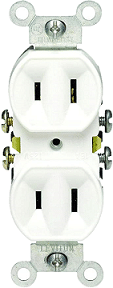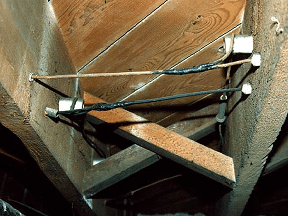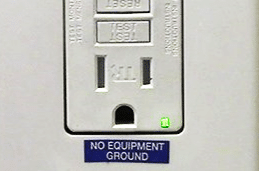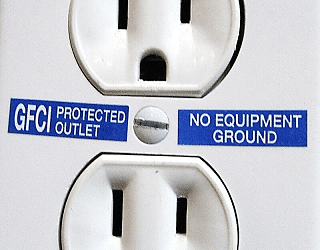Why Are Two Prong Outlets Dangerous?
Two prong outlets are inherently unsafe and can be extremely dangerous. They are a well-known cause of residential home fires worldwide. According to the U.S. Fire Administration, 12 percent of residential homes fires in the United States involve outlet receptacles.

Because two-prong receptacles do not offer any such ground-fault protection, occupants may be exposed to shock or electrocution hazards. Additionally, without the presence of an equipment grounding conductor, high ampere fault conditions are carried back to the main electrical panel via the neutral conductor. Repeated fault cycles will degrade the wire insulation which can eventually lead to arcing or a structure fire. This is why two-prong receptacles are dangerous.
History of Ungrounded Receptacles
Old two-wire knob and tube circuits were installed in the United States from the 1880s through the 1950s. Beginning in the 1930s new wiring methods were developed, which eventually supplanted new knob and tube installations inside homes. 
What Options Do I Have to Replace Existing Two Prong Outlets?
The National Electric Code (NEC) section 406.4(D)(2) provides three replacement options for existing two-prong receptacles that do not have a connection to an EGC.
The first option allows existing two-prong receptacles to be replaced with new two-prong receptacles. For most homeowners this is the least attractive option for a few reasons. First, this option does not change the receptacle’s configuration to the ubiquitous three prong configuration required by nearly all modern appliances and electrical devices. Second, this option provides no dedicated EGC or ground-fault path, for safety. Third, without remedy of the first two, the homeowner or occupants are left with a potential shock hazard or worse yet lethal electrocution risk.


When to Upgrade Wiring and Ungrounded Receptacles
It is important to note, although the NEC allows replacement of two-prong receptacles with ungrounded outlets without installing new wire with an equipment grounding conductor, some equipment and appliance manufacturers require an electrical circuit that includes a connection to an EGC. Additionally, section 250.114 requires certain corded appliances to be connected to an equipment ground. Specifically in residential applications, refrigerators, freezers, air-conditioners, washing machines, clothes dryers, dishwashers, ranges, garbage disposals, IT equipment, and sump pumps all require an equipment grounding conductor and therefore a grounded three-prong receptacle. Finally, newer equipment with sensitive onboard electronics, particularly DC inverters, electronically commutated motors (ECM), and variable frequency drives may require an equipment grounding conductor in addition to the neutral in order to operate properly or safely.
The overall best option is to remove or abandon any old two conductor wires, and install new wire with an integral equipment grounding conductor. This method allows three-prong receptacles to be installed with the full protection afforded by the EGC safety mechanism. Obviously, this option is the most invasive requiring cutting into existing walls, ceilings and floors. Additionally, rewiring a home is expensive and may range from a low of $8,000 to as much as $40,000 depending on the size of the home, complexity of electrical system, and luxury features. Alternatively, section 250.130(C) of the NEC allows a separate EGC to be installed and bonded at a variety of points to achieve a solid ground connection. This option is available on existing installations without an EGC. Those ground connection points include the grounding electrode, grounding electrode conductor (GEC), equipment grounding terminal at the panel where the electrical branch circuit originates, and an adjacent EGC of another branch circuit that originates in the same panel. Installing a separate EGC may sound like a cost-effective alternative to installing a new circuit, however, the need to open walls, ceilings or floors and the time required to fish a single conductor does not provide any real savings. When choosing between an alternative EGC only option or a rewire, the cost is nearly identical. Given that, the best option is always to replace the entire cable with all new wire and receptacles.
Home Performance Electrical Repair in Kansas City
Concerned about old ungrounded outlets? Purchasing an appliance that requires three-prongs and a dedicated equipment ground? Received an electrical shock at a two-prong receptacle? Consider hiring an electrical professional with real-world experience and specialized code knowledge to safely replace ungrounded receptacles. An upfront investment in careful contractor selection can save both the headache of inconvenience and potential electric hazards.
At Home Performance Group, we continue to invest in electrical training so we can correctly assess, diagnose, specify, install safe electrical systems, upgrades, and repairs. We have performed numerous projects for our clients.
If you are interested in a no-cost in-home consultation, schedule with a Solutions Advisor today.

Article by Larry L. Motley Jr., 31 January 2022
Larry is a graduate of both Wentworth Military Academy and Missouri Western State University earning a double bachelor’s degree in Economics and Finance. Additionally, he maintains six professional tradesman licenses in two states and advanced credentialing in green technology, project and program management, and process improvement. Larry is a three-time combat veteran having served in Operation Iraqi Freedom, Operation New Dawn, and Operation Inherent Resolve. He continues to serve through a value-based building science company focused on providing clients the best design, highest quality installation, and most honest repair services in the community.


Featured Service Areas:
| Missouri | Kansas | ||||
|---|---|---|---|---|---|
|
Belton Blue Springs Cameron Excelsior Springs Gladstone Holt |
Independence Kansas City Kearney Lathrop Lawson Lee's Summit |
Liberty North Kansas City Parkville Platte City Plattsburg Polo |
Raytown Riverside Smithville Sugar Creek Weston |
Kansas City Lansing Leavenworth Leawood Lenexa |
Merriam Mission Mission Hills Praire Village Shawnee |






















